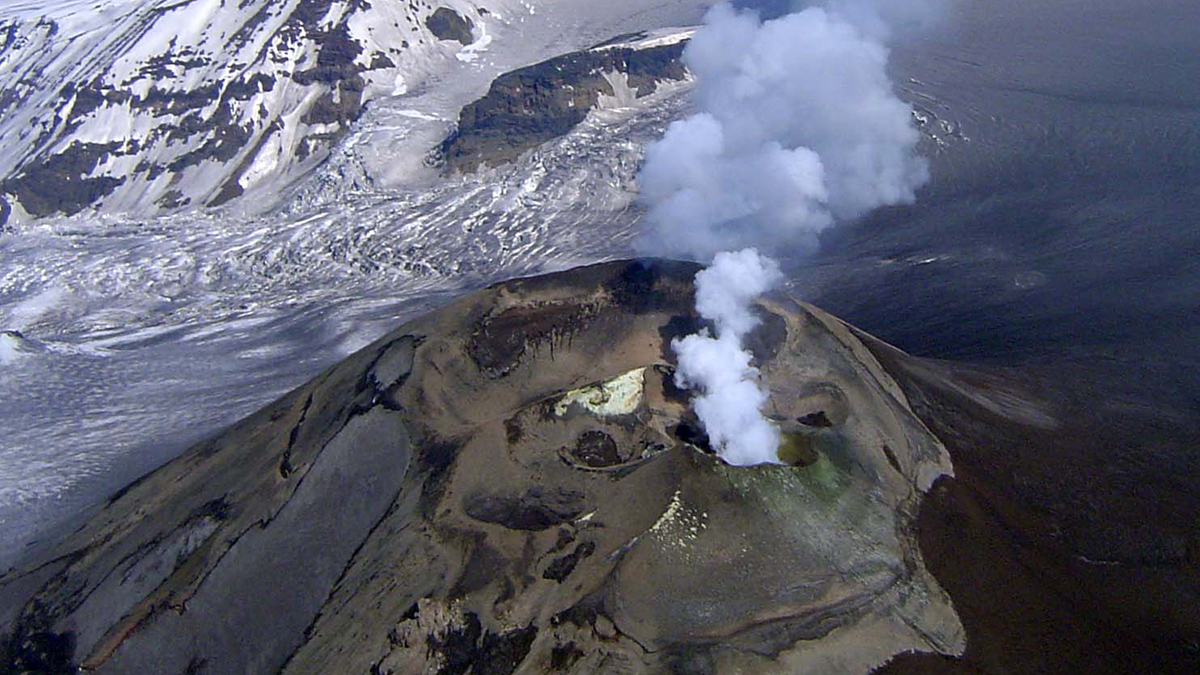Despite a history of frequent activity, Mount Veniaminof often erupts without warning. Unlike most volcanoes, the ice-covered mountain in Alaska’s Aleutian Islands doesn’t rumble or bloat in the days to weeks prior to an event.
Now, new research is shedding light on factors contributing to this “stealthy” behavior: Veniaminof has a small magma reservoir, the surrounding rocks are warm, and magma flux is relatively low. Researchers presented their results on 11 December at AGU’s Annual Meeting 2024 in Washington, D.C.
Understanding the complex interplay of these different factors enables scientists to create more accurate models to predict future volcanic activity and mitigate potential risks.
An increase in earthquake frequency and intensity, as well as in ground swelling or subsidence (deformation), can signal that magma is on the move and an eruption may be imminent. To monitor these changes, many volcanoes are outfitted with seismometers, and networks of satellites regularly sync with receivers on the ground to measure the shape of the volcano.
“Before each eruption, we expect to see a very obvious [increase] in the number of earthquakes caused by the intrusion of magma. But for this volcano, we didn’t see such signals.”
Only two of Veniaminof’s 13 eruptions since 2002 have exhibited these precursory signs. “Before each eruption, we expect to see a very obvious [increase] in the number of earthquakes caused by the intrusion of magma. But for this volcano, we didn’t see such signals,” said Yuyu Li, a graduate student at the University of Illinois Urbana-Champaign studying geophysics and volcanology, and the study’s lead author.
Without these signs, the Alaska Volcano Observatory can’t provide eruption warnings to aircraft or nearby communities.
Li and her colleagues created a 2D model of Veniaminof to simulate how the magma chamber inflates in an upward and sideways motion as magma rises. The researchers then compared the model’s predictions with actual measurements of ground movement to check whether they align.
The analysis suggested that Veniaminof does not store a lot of molten rock because it has a small magma chamber. Magma in Veniaminof also moves slowly, much slower than in volcanoes with bigger magma chambers. This slow flow “creates conditions favorable for ‘stealthy’ eruptions,” Li said.
In addition, because of prolonged magma storage, the heat from the magma keeps the surrounding rocks warm. This makes them less likely to shift or crack, which are often signs that an eruption might be imminent.
Veniaminof is not the only volcano that erupts with little to no signals. Several other Aleutian Arc volcanoes exhibit “stealthy” eruptions, including Cleveland, Pavlof, and Shishaldin. Elsewhere, volcanoes such as Stromboli in Italy, Popocatépetl and Colima in Mexico, and Merapi in Indonesia also demonstrate this behavior.
Though different factors may influence individual volcanoes, the findings of the study offer insights for understanding why some volcanoes may lack prominent preeruptive signals.
“Since our study is based on time-independent models, it helps provide constraints on the intervals between eruptions, the level of eruption needed, and whether conditions are conducive to initiating an eruption through rock failure,” Li said.
Monitoring Challenges
“It raises the question of whether there is actually no seismicity beforehand and no deformation, or the lack of precursory signals is simply because the instruments are not close enough.”
A key challenge in monitoring Veniaminof and other Aleutian volcanoes is the distance between eruption sites and seismic monitoring stations, stressed Diana Roman, a geophysicist at the Carnegie Institution for Science who was not involved in the study. The remote and ice-covered terrain makes it difficult to install instruments sufficiently close to active vents. Currently, eight permanent seismic stations are situated in and around Veniaminof.
“It raises the question of whether there is actually no seismicity beforehand and no deformation, or the lack of precursory signals is simply because the instruments are not close enough,” Roman said. “It’s much harder to detect things like deformation when you have a snow-covered edifice, or when you have Global Navigation Satellite System receivers that are farther away,” she added.
John Power, a volcano seismologist at the Alaska Volcano Observatory, highlighted the importance of understanding Veniaminof’s behavior. Veniaminof’s eruptions produce low-level ash clouds that can severely disrupt air traffic—a lifeline for the sparsely populated, isolated communities on the Alaska Peninsula, he said.
“We’re always interested in what Veniaminof is doing. [Though its eruptions] typically impact just the local communities around the volcano, it certainly has the ability to produce higher-altitude ash clouds. That would be hazardous to more people,” Power said.
—Gaea Cabico (@gaeacabico), Science Writer


